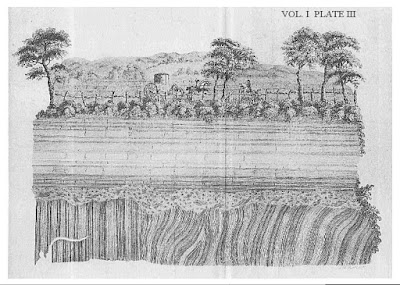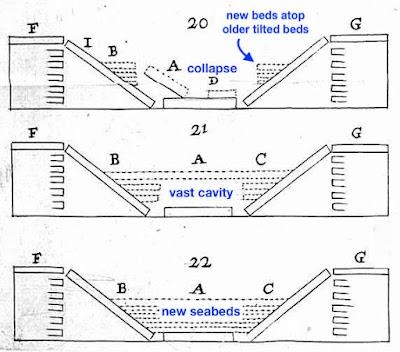“I rejoiced at my good fortune in stumbling upon an object so interesting to the natural history of the earth …” James Hutton, 1788
 |
| Me too, James! |
On a cool sunny day, almost a year ago now, I drove down the valley of the Dry Cimarron River in northeast New Mexico. On either side were rock walls—brown, red, yellow and almost white sandstones and mudstones, earthy and rich against the bright sky. They were neatly stacked in horizontal layers—not so different from several hundred million years ago, when they were still beds of sediment.
But then I came upon Steamboat Butte (1), with its rocks askew! Here was an example of the “object” that had brought such great joy to James Hutton 230 years ago—an angular unconformity. Underneath a cap of horizontal sandstone were tilted redbeds.
Whenever I see an angular unconformity I also see, in my imagination, a hand-waving geologist expounding on its creation, interpreting the story told by the rocks. But on that day, all I had was a rather laconic guidebook, which intoned: “The underlying Triassic Travesser Formation was tilted and eroded before the overlying Jurassic Entrada Sandstone was deposited.” I had hoped for more—I wanted to “rejoice” and “grow giddy” looking into the deep abyss of time! So when I returned home, I consulted with two men famous for profound geological insights that stemmed in part from their study of angular unconformities—Nicholas Steno and James Hutton.
 |
|
Nicholas Steno—anatomist, pioneering geologist, bishop, saint (Wellcome Collection).
|
Nicholas Steno worked in the Tuscan part of the Apennine Mountains in the mid 1600s, initially studying fossils. He was barely a geologist, but that was only because in his day geology was still in its infancy. Steno came up with some of our most basic geological principles, which he published in 1679 in his Prodromus. It was to be a brief introduction to a lengthy dissertation on geology, paleontology and more, but he never wrote it (2). Still, there was enough in the Prodromus to start a revolution in thinking about Earth history.
At that time, it was widely believed that when God made the Earth, it was pretty much as it is now. The land has been eroded, that can be seen. But erosion is far too slow to have much impact. Steno concluded otherwise—that the Earth had changed significantly, and would continue to do so, as God intended. He had found convincing evidence, most famously seashells on mountaintops.
Steno also saw evidence of change in tilted sedimentary rocks, which began as sediments deposited in water, i.e., as horizontal beds (his principle of original horizontality). Given that they’re now "at an angle to the horizon", something must have happened. But what? Steno attributed tilting to collapse of rock layers into a large cavity. He described this interpretation in the Prodromus, with cross-sections and a brief summary. “Here I shall only reckon up in short the order of the change” (for details, readers were referred to the promised dissertation).
Steno's description proceeds from past to present. Figure 25 shows a seafloor with “beds yet entire, & parallel to the horizon.” In 24, a vast cavity has been “eaten out by the force of Fire and Water, without any breach in the upper Beds.” Eventually the upper Beds collapse (23), creating a valley with tilted rocks on either side.
In the valley, now filled with seawater, “new Beds” form (22). Fire and water again eat out a cavity (21), and the upper Beds collapse (20). But this time, the breach reveals old tilted beds below the horizontal new Beds—an angular unconformity!
Broadly-speaking, Steno’s explanation is similar in many ways to today’s thinking, and was remarkable given the paucity of geological knowledge then. Collapse of large cavities is no longer accepted, yet modern thinking does incorporate collapse of rock beds in some cases, though not as a separate step. Rocks are too weak to form superior beds over a huge cavity; instead, they collapse as land is being downwarped (Alvarez 2009).
 |
|
Steno would say the redbeds collapsed into a cavity before the red-and-white sandstone above was formed.
|
 |
|
James Hutton—chemist, gentleman farmer, pioneering geologist (1776, source).
|
In 1787, James Hutton was walking along the Jed Water in the Scottish Borders, his eyes glued to the rocks. At Inchbonny, he was stopped in his tracks:
“I was surprised with the appearance of vertical strata in the bed of the river, where I was certain that the banks were composed of horizontal strata [italics added]. I was soon satisfied with regard to this phenomenon, and rejoiced at my good fortune in stumbling upon an object so interesting to the natural history of the earth, and which I had been long looking for in vain. … Here the vertical strata, similar to those that are in the bed of the Tweed, appear; and above those vertical strata, are placed the horizontal beds, which extend along the whole country.”Hutton had found an angular unconformity! (he called it a junction). His friend John Clerk made a drawing, which appeared in Hutton’s Theory of the Earth (1788).
 |
|
Hutton’s Unconformity at Inchbonny, drawn by John Clerk (source).
|
After studying multiple exposures of the junction, Hutton came up with an explanation. The vertical beds, which he called the schistus, were marine sediments turned to rock, due to pressure and heat. The seafloor was heaved up to form land, tilting the beds, which were “laid bare” (eroded) into a roughly flat surface. Then the land subsided, and another cycle began (3). Now the sand-stone was deposited, and again the seafloor was heaved up and laid bare. But this time, erosion revealed the schistus/sand-stone junction (4).
However, there was a major problem with this story. The processes Hutton invoked—deposition, uplift, erosion—were much too slow. To complete the two cycles needed to create and reveal the junction would require an immense amount time, far more than the 4000-6000 years said to be the age of the Earth. But Hutton was not one to be constrained by dogma. He concluded that the Earth was far older than people thought; the schistus–sand-stone junction (now called the Hutton Unconformity) was proof. It was Hutton who introduced the concept deep time, critical to geology. With deep time, even a very slow process can produce major change.
 |
|
Hutton’s Unconformity at Siccar Point; gently tilted sand-stone above near vertical schistus (source).
|
Two centuries have passed since Hutton described the junction he found in the Scottish Borders. Yet his interpretation of angular unconformities is very much the same as today’s: the lower rocks were tilted, and then buried in sediments that would become the upper rocks … as in the case of Steamboat Butte.
The angular unconformity at Steamboat Butte is far younger than Hutton’s, but it still provides the thrill and joy of peering into deep time. In fact, to describe the experience we would need to modify only slightly the words of John Playfair—Hutton's friend who accompanied him to Siccar Point:
“We felt necessarily carried back to a time when the redbeds on which we stood were as yet the surface of the land, and when the sandstone before us was only beginning to be deposited in the shape of sand dunes, fashioned by the wind ... The mind seemed to grow giddy by looking so far back into the abyss of time!”
 |
|
Stop and read the rocks—so much to learn, such joy to be had!
|
Notes
(1) Steamboat Butte is sometimes called Battleship Mountain.
(2) Shortly after the Prodromus was published, Steno abandoned geology, devoting the rest of his life to the Catholic Church. He died in 1686, and was beatified in 1988.
(3) Hutton considered the Earth to be in a steady state maintained by elevation and erosion—a series of cycles with “no vestige of a beginning – no prospect of an end”.
(4) Hutton’s “schistus” is now known to be Silurian sandstones and shales (433 Ma). The “sand-stone” is today’s Devonian Old Red Sandstone (370 Ma) (Prothero 2018).
(5) The timing of Travesser redbeds tilting is unclear; apparently it wasn't associated with mountain-building. The Ancestral Rocky Mountains (circa 300 Ma) predate the redbeds, and today’s Rockies (Laramide Orogeny, circa 70-50 Ma) are younger than the sandstone. Muehlberger et al. (2005) refer only to a “pre-Entrada fold”. Parker (1933) reported numerous such folds in the Dry Cimarron area.
Sources
Alvarez, W. 2009. The Mountains of Saint Francis; discovering the geologic events that shaped our earth.
Baldwin, B., and Muehlberger, W.R. 1959. Geologic studies of Union County, New Mexico. New Mexico Bureau of Mines & Mineral Resources Bulletin 63.
Cutler, A. 2003. The Seashell on the Mountaintop. A biography of Steno emphasizing his pioneering contributions to geology and paleontology.
Hutton, J. 1788. Theory of the Earth. Transactions of the Royal Society of Edinburgh, 1.
Muehlberger, WR, Muehlberger, SJ, and Price, LG. 2005. High Plains of northeastern New Mexico, a guide to geology and culture. NM Bureau of Geology and Mineral Resources.
Open University provides a clear interesting account of Hutton’s geology.
Parker, BH. 1933. Clastic plugs and dikes of the Cimarron Valley area of Union County, New Mexico. Journal of Geology 41: 38-51.
Prothero, DR. 2018. The story of the Earth in 25 rocks. Columbia University Press.
Steno, N. 1671. The Prodromus to a dissertation concerning solids naturally contained within solids. Laying a foundation for the rendering a rational account both of the frame and the several changes of the masse of the Earth, as also of the various productions in the same. English translation




Nice info... It helped a lot... Thank you...
ReplyDeleteThanks for visiting!
Delete